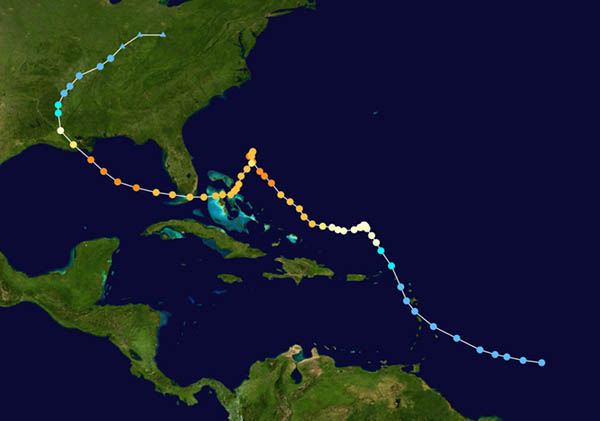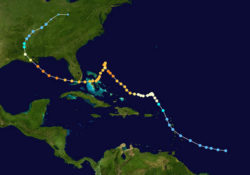Hurricane Betsy
One of the most destructive storms in Louisiana history, Hurricane Betsy made landfall on September 9, 1965.
This entry is 8th Grade level View Full Entry

National Hurricane Center via Wikimedia Commons
Tracking Map of Hurricane Betsy.
Tropical hurricanes have posed a constant danger to Louisiana’s coastal residents for centuries. The 1965 Atlantic hurricane season was one of the least active seasons on record. Only six cyclones grew to tropical-storm strength. One of them was Hurricane Betsy, which made landfall in Louisiana on September 9, 1965. Seventy-six people died, and the storm was the first hurricane to cause more than $1 billion in damages. The damage caused by Hurricane Betsy in 1965 led to the creation of the US Army Corps of Engineers’ Hurricane Protection Program. This program was responsible for building the New Orleans levees that failed during Hurricane Katrina in 2005. Until Katrina, Hurricane Betsy was the defining hurricane in New Orleans’s collective memory.
How dangerous was Hurricane Betsy?
On August 27, 1965, the US National Oceanic and Atmospheric Administration (NOAA) tracked the storm and named it Betsy. Two days later, on August 29, it reached hurricane strength when 80 mile-per-hour winds were recorded near the center of the storm. Hurricane advisories were issued right away. In the next two days, Betsy was downgraded to a tropical storm when winds decreased to 65 mph, but on September 1, Betsy headed west and regained hurricane strength. On September 2, peak winds were estimated at 125–150 mph. After skirting the Bahamas, the unusual storm performed another loop, then moved southward before finally hitting south Florida with hurricane-force winds that lasted for twelve hours. Damage there was estimated at $100–150 million at the time, and four people were killed. The storm passed over Florida and then regained strength in the warm waters of the Gulf of Mexico.
As the hurricane approached the Louisiana coast on September 9, the winds were estimated at 150 mph. Heavy rain, high tides, and tornadoes were forecast for the region. Offshore oil platforms were evacuated. By 6 p.m. the Grand Isle Coast Guard station reported wind gusts of 160 mph and sea level pressure of 28 inches—the lowest pressure ever recorded in Louisiana at that time. At 9 p.m. the center of the storm passed thirty miles west of Burwood at the mouth of the Mississippi River and made landfall near Grand Isle at 11 p.m. Although the current system to rate hurricanes was not in place, by today’s standards Betsy would have been a Category 4 storm. Continuing northward, the center of the storm passed over Houma and west of Baton Rouge, still maintaining 100 mph winds. As it went further inland, it lost strength. By the time what was left of Betsy reached Memphis, Tennessee, on September 11, it was no longer a tropical storm.
What were the long-term effects of Hurricane Betsy?
A ten-foot storm surge flooded New Orleans for days. Levees in the Lower Ninth Ward and on both sides of the Industrial Canal failed. More than 164,000 New Orleans homes were flooded. Many drowned in the Ninth Ward and nearby St. Bernard Parish when water reached people’s roofs. Some drowning victims were found in their attics after the water receded, where they had tried to escape from flooding. Almost sixteen feet of water flooded Grand Isle, destroying or damaging every building. In St. Bernard Parish, floodwaters swept away the fishing villages of Delacroix Island and Yscloskey. Over a large region, sugarcane, cotton, and pecan crops were destroyed, and thousands of livestock drowned. Hundreds of ships, barges, and oilfield facilities were sunk or damaged. Shipwrecks blocked thirty miles of the Mississippi River channel. The total estimated storm damage was $1.42 billion (equal to $10.2 billion in 2020 dollars). Betsy was the first hurricane to cause damage of more than $1 billion, and the majority was in Louisiana. There were approximately seventy-six deaths (reports vary), mostly in Louisiana. Because of the scale of the devastation, the name Betsy is no longer used to name tropical cyclones.
President Lyndon Johnson visited New Orleans after the storm at the request of Louisiana Senator Russell Long. President Johnson promised to provide relief as soon as possible. After surveying the damage, Louisiana Governor John McKeithen promised that “nothing like this will ever happen again” and vowed that the state would put into place “procedures that will someday in the future make a repeat of this disaster impossible.” Even though McKeithen advocated a states’ rights platform in response to civil rights legislation, he actively sought federal funding to rebuild Louisiana after the flood. “Americanism in our state has … been reawakened and revitalized,” he said, “because … when we got in trouble … no suggestion was made, ‘Well, you people have been talking down there about states’ rights. You can take care of your own problems.’ ” He added that Louisianans were “greatly appreciative of the spontaneous and enthusiastic manner in which the federal government has come in here to help us.”
Emergency relief came in many forms. Trailers were provided for the homeless. In order to provide long-term assistance in future disasters, the Corps of Engineers created the Hurricane Protection Program. New Orleans levees were redesigned and built to protect against a powerful and fast-moving cyclone like Hurricane Betsy. Unfortunately, the requirements to resist such a storm are different from those needed to prevent destruction by an intense, slow-moving hurricane like Katrina.
